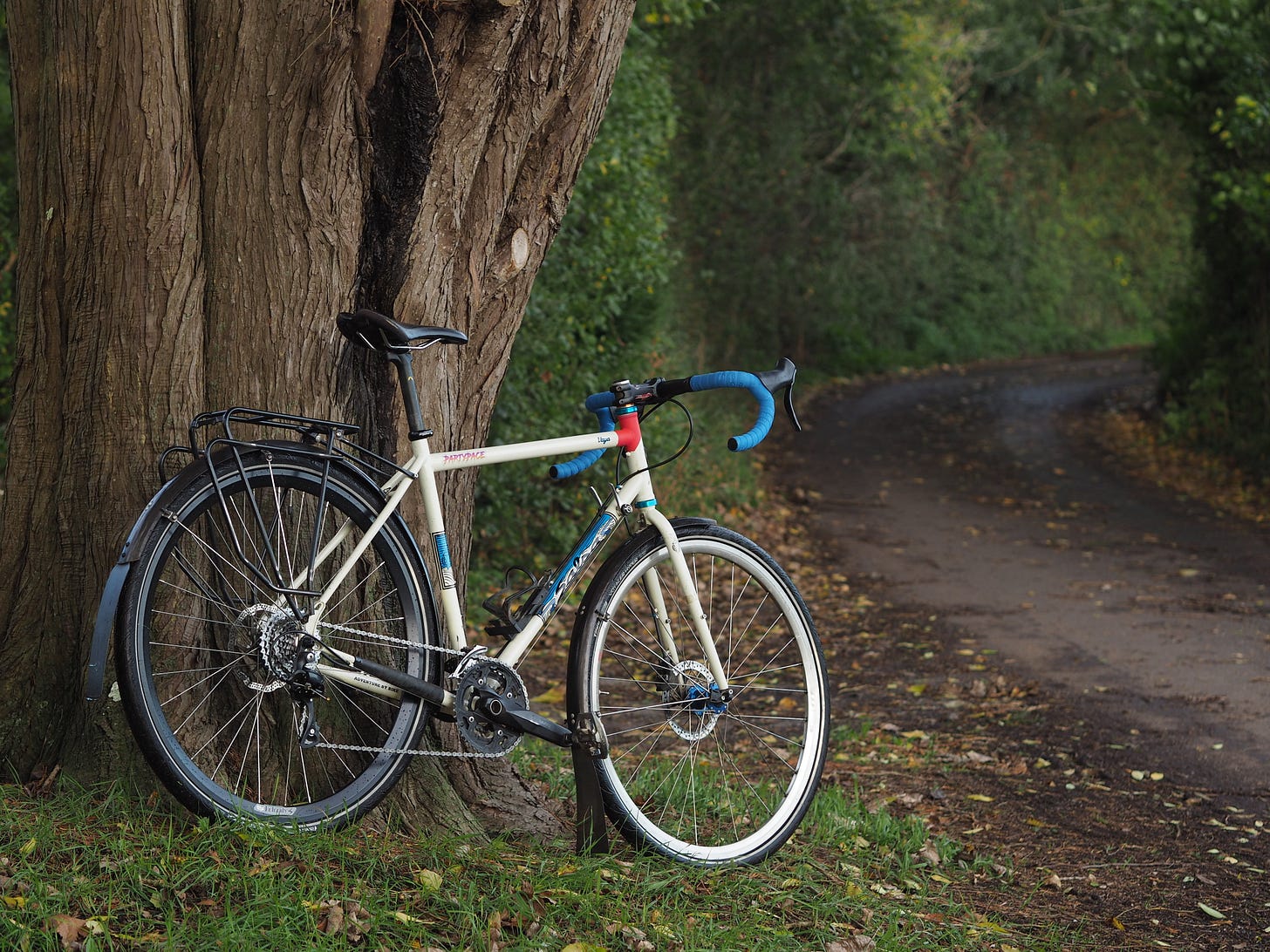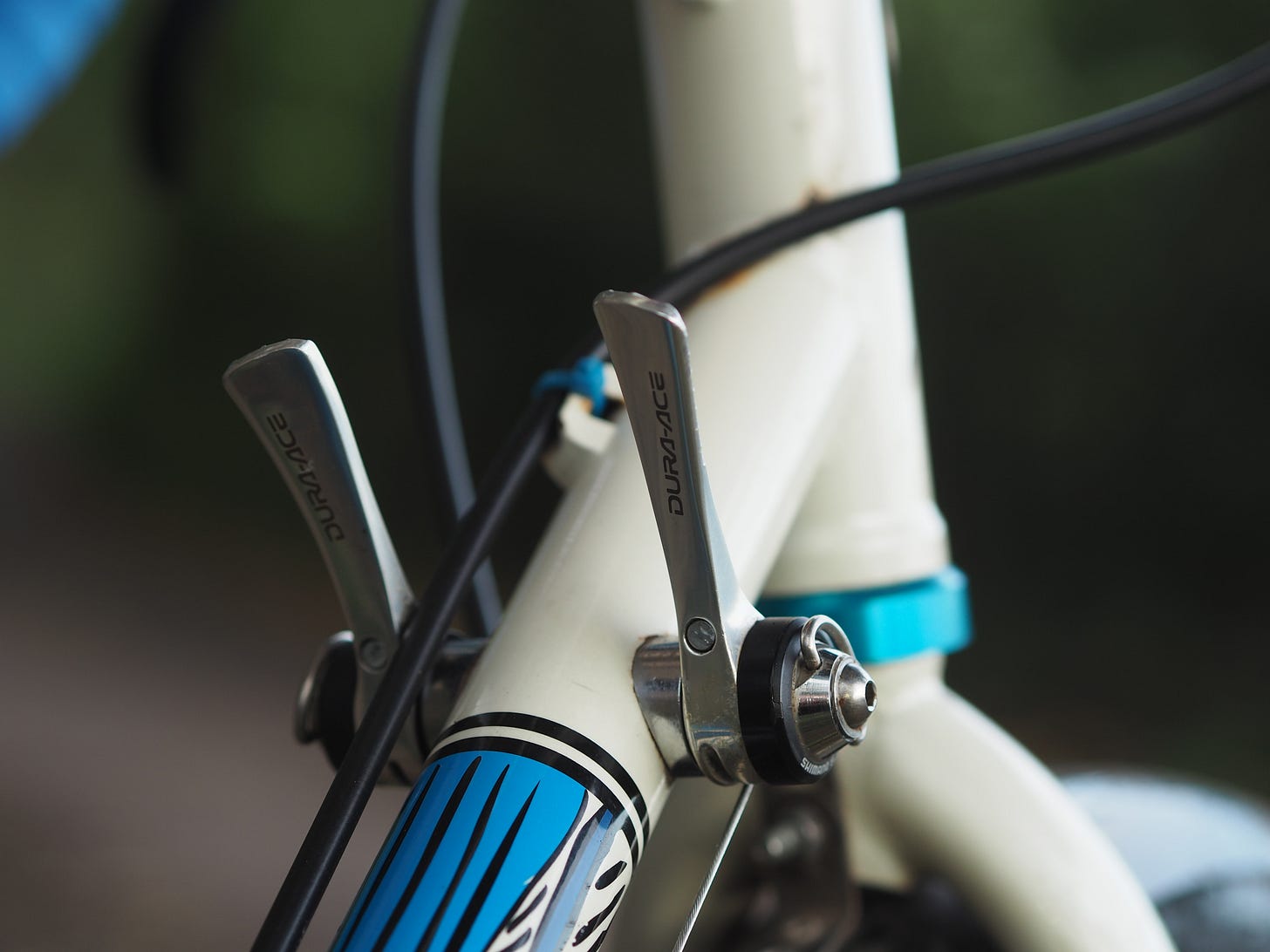From 1994, when I bought my first “proper” mountain bike, to 2012, I only rode mountain bikes. I didn’t think I’d like road cycling very much, and I didn’t have enough money for more than one bike anyway.
My first time looking at road bikes came after I tore my anterior cruciate ligament during a basketball match. I’d been surgically reconstructed and the consultant suggested that cycling was a good thing to do during my rehab, but only on the road, since a fall while riding off-road was more likely to result in reinjury. I had no clue what a good road bike might be, so I stuck to looking at brands I recognised from mountain biking and soon found that Kona was selling a very pretty steel-framed, retro-ish road bike. I arranged a test ride.
As well as being aesthetically pleasing, it had tyres far skinnier than any I’d ever used before, much more twitchy geometry than I was used to and downtube shifters. The last of these, Kona’s marketing assured me, was a nod to the bike’s faux-retro vibe. It probably didn’t hurt that they were cheaper than the equivalent integrated brake lever and shifter units that most bikes came with, but where’s the romance in that?
The test ride was brief, wobbly and a little bit terrifying. Every time I reached for the downtube to change gear the bike tried to deviate from the direction I’d been intending it to go in, the additional sensitivity to rider input was more than I had the skill to adjust for. But I did manage to change gear a few times before returning to the shop and letting the sales assistant know I’d decided it wasn’t the one for me. And what wonderful, tactile gear shifts they were, the beginning of an infatuation.
If you have never ridden a bike with downtube shifters, you must try one at some point. Make sure you give it more of a chance than I did that first time, because there is a bit of a learning curve. I think if I’d given the Kona fifteen minutes rather than five, I may have fallen in love with it. Instead, I ended up with a perfectly fine, unremarkably competent Specialized road bike which carried me for many happy miles, but which had the type of vague gear shifts which are something you put up with rather than enjoy. Still, at least I didn’t feel like I was going to crash every time I selected a different ratio.
A few years later I was looking for a bike to use for commuting and found a second hand Salsa Vaya touring bike for sale nearby. It was a real parts bin special, cobbled together from a range of mismatched parts which had come from other bikes. Perfect for commuting; a nice bike masquerading as a rubbish one.
The nicest parts on it were a pair of truly lovely Dura Ace downtube shifters. Despite having several years of skinny-tyred, twitchy-geometry riding under my belt by this point, I was still a little wary. I figured I’d give them a go, wobble a lot, probably fall off, then remove and sell them.
Turns out, a touring bike is much less highly-strung than its racier cousins. The Vaya has bigger tyres, slacker and more upright geometry. It is a forgiving bike, and the perfect platform for me to get to know and appreciate those shifters. I’ve owned that bike for ten years now and ridden more miles on it than any other (the vast majority of my riding is commuting, unfortunately) and almost every component has been changed during that time, but not the shifters.
What’s so great about them?
Fairly obviously, a downtube shifter is closer to the derailleur it’s operating than any other type of shifter. Because they’re closer, there’s less cable. There’s also less cable housing, which means there’s less friction in the system. Friction is the enemy of good gear shifts, and no mechanical shifter has less of it than a downtube shifter.
They’re also incredibly simple. Shifters that are integrated with a brake lever are made of lots of tiny pieces. There are ratchets. Springs. Other things. Lots of moving parts working in harmony to pull the cable. Very clever, but not simple. A downtube shifter has about four parts in total, and only one of them moves.
The lack of friction and the simplicity of the mechanism makes them feel fantastic. The sense of connection to the process of changing gear is second to none. The shape of the lever itself is organic and smooth too, it always reminds me of those bits in science fiction where the human characters come across an alien race which has managed to fuse the organic and the mechanical.
But the thing I love about them the most is that they are symbolic of riding a bike in a different way. There is no shifting gears mid-sprint. You should probably think carefully about whether it’s a good idea to reach for the lever mid-corner, on a sketchy descent, or in any other situation where having both hands on the bars might be the difference between staying upright and having an accident. Downtube shifters will not make you faster, and that’s okay. They will make you think about whether you really need to change into the optimal ratio to maintain your cadence, or if you could just enjoy a more relaxed type of riding for a while. They are the inefficient, time-waster’s way of changing gear. The shifter of bucolic summer evenings with your head raised to look over the fields and hedgerows, spotting birds and other wildlife.
They are the shifter of the meanderer, the rider in no rush to reach their destination, of enjoying the ride for the sake of it, of turning off your speedometer, or at least putting it out of sight.
You should try some and, if you do, let me know what you think.






A well-written argument in favour of the humble downtube shifter! I agree with most of it but have found they get a bit tedious after 100km.
I’m fine with DTS. Quite like bar end shifters though. Never tried integrated levers so can’t compare!